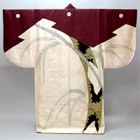Japanese Gallery (Honkan) Rooms T1 & T2
June 9, 2015 (Tue) - August 2, 2015 (Sun)
In 1875, Noguchi Hikobei (1848–1925) established the Daihiko Textile Merchant in the Tachibana area of Nihonbashi, Tokyo. Believing that to create something new, “one must gain a wide range of knowledge and experience, improve one’s ability to discern quality and value, and be shrewd in separating the good from the bad,” he amassed a collection of Edo-period (1603–1868) kosode garments around the turn of the century. At the time, kosode, which are the predecessors of modern-day kimono, were bought and sold as second-hand clothing and rarely attributed with historical or artistic value. The Daihiko Collection deserves attention not only because of its high quality, but also because it predates other existing kosode collections and reflects how Noguchi was the first to recognize the value of these garments.
Moreover, Noguchi did not limit himself to collecting. He attempted to categorize kosode based on the time periods their styles reflected and the dyeing techniques they employed, using his own collection and Edo-period books with illustrations of garment designs as references (these books are comparable to modern-day fashion magazines). These efforts are revealed by hand-written tags attached to his kosode garments. His research was highly unique even though it was based on stylistic categories used by textile merchants during the late 19th and early 20th century.
This thematic exhibition focuses on Noguchi as a textile merchant, rather than as a scholar, who contributed to research on Edo-period kososde. It features carefully-selected masterpieces and rare examples from his collection.

